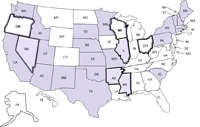Nonpasteurized Disease Outbreaks, 1993-2006
New Publication
Volume 18, Number 3—March 2012
Nonpasteurized Dairy Products, Disease Outbreaks, and State Laws—United States, 1993–2006[PDF - 7 pages]
Although pasteurization eliminates pathogens and
consumption of nonpasteurized dairy products is
uncommon, dairy-associated disease outbreaks continue
to occur.
To determine the association of outbreaks caused by nonpasteurized dairy products with state laws regarding sale of these products, we reviewed dairy-associated outbreaks during 1993–2006.
We found 121 outbreaks for which the product's pasteurization status was known; among these, 73 (60%) involved nonpasteurized products and resulted in 1,571 cases, 202 hospitalizations, and 2 deaths. A total of 55 (75%) outbreaks occurred in 21 states that permitted sale of nonpasteurized products.
- Article PDF: Nonpasteurized Dairy Products, Disease Outbreaks, and State Laws—United States, 1993–2006 [PDF - 7 pages]
- Questions and Answers: What is this study about?
- Press Release: Majority of dairy-related disease outbreaks linked to raw milk
- Matte Release: Got Raw Milk? Don't Drink It![PDF - 1 page]
- Podcast:Raw or Nonpasteurized Products Can Make You Sick
- CDC Feature: Raw (Unpasteurized) Milk
Nonpasteurized (Raw) Dairy Products, Disease Outbreaks, and State Laws—United States, 1993–2006
Questions and Answers
What is this study about?
- This study reviewed outbreaks caused by dairy products in the United States that were reported to CDC during 1993–2006. The study compared outbreaks caused by raw—or unpasteurized—dairy products and outbreaks caused by pasteurized dairy products in terms of the types of infection; the numbers of outbreaks, illnesses, hospitalizations, and deaths; and age and sex of the ill people in the outbreaks.
- The study also compared the number (incidence) of outbreaks caused by raw dairy products in 21 states that allowed the legal sale of raw dairy products vs. states that prohibited the sale of raw dairy products. During the study period (1993-2006), 21 states allowed the legal sale of raw dairy products, 22 states did not, and 7 states changed their laws. At the end of the study period (2006), 24 states allowed the legal sale of raw dairy products, and 26 did not.
What did the study show?
Raw milk was much more likely to cause outbreaks than pasteurized milk.
- During 1993–2006, 121 outbreaks reported to CDC were caused by dairy products where the investigators could determine if the dairy product was pasteurized or unpasteurized (raw). These outbreaks included 4,413 illnesses, 239 hospitalizations, and 3 deaths.
- 73 outbreaks (46 from fluid milk and 27 from cheese) were caused by raw milk, and 48 outbreaks (10 from fluid milk and 38 from cheese) were caused by pasteurized milk.
- Probably no more than 1% of the milk consumed in the United States is raw, yet more outbreaks were caused by raw milk than by pasteurized milk.
- If you consider the number of outbreaks caused by raw milk in light of the very small amount of milk that is consumed raw, the risk of outbreaks caused by raw milk is at least 150 times greater than the risk of outbreaks caused by pasteurized milk.
Outbreaks caused by raw milk tended to cause more severe disease.
- The hospitalization rate for patients in outbreaks caused by raw milk was 13 times higher (13% vs. 1%) than the rate for people in outbreaks caused by pasteurized milk.
- This difference is probably partly because the outbreaks caused by raw milk were all caused by bacterial infections that tend to be more severe. For example, E. coli O157:H7, a bacterium that can cause kidney failure and death, was a common cause of outbreaks due to raw milk. For outbreaks caused by pasteurized milk, relatively mild viral infections and foodborne toxins were more common causes.
- This difference makes sense because raw milk is probably contaminated at the time of milking of the cows. The skin of cows is contaminated with huge numbers of bacteria, even if sanitary precautions are taken. Some of the bacteria, while harmless to the cows, can cause disease in people. On the other hand, if pasteurized milk is contaminated after pasteurization, it is likely to be due to improper storage or by an infected food preparer. In these situations, serious bacterial infections are less likely to happen.
Younger people were affected more in outbreaks caused by raw milk than in outbreaks caused by pasteurized milk.
- During 1993–2006, 60% of people sickened in outbreaks caused by raw milk were under 20 years of age, versus 23% of people in outbreaks caused by pasteurized milk.
- The American Academy of Pediatrics and many other professional organizations advise against feeding raw milk products to children.
States that allow the sale of raw milk had more outbreaks caused by consuming raw milk.
- During 1993–2006, 55 outbreaks—or 75 percent— caused by raw milk occurred in states where it was legal to sell raw milk products.
- The rate of outbreaks caused by raw fluid milk is over twice as high in states that allow the sale of raw milk than in states than prohibit its sale.
- The rate of outbreaks caused by raw cheese is nearly six times as high in states that allow the sale of raw milk than in states that prohibit its sale.
- Restricting the sale of raw milk products is effective in reducing outbreaks caused by raw milk.
Get email updates
To receive email updates about this page, enter your email address:
Contact Us:
- Centers for Disease Control and Prevention
1600 Clifton Rd
Atlanta, GA 30333 - 800-CDC-INFO
(800-232-4636)
TTY: (888) 232-6348
24 Hours/Every Day - cdcinfo@cdc.gov







